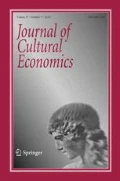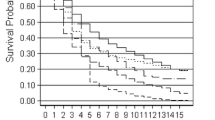Abstract
The now-substantial literature on the career age-valuation profiles of artists has paid limited attention to the effects on the profiles of association with artistic movements. There are nonetheless many reasons why association with a more or less well-defined movement can be important for the career dynamic of an artist. The relation between careers and movement association has been studied by Accominotti (Poetics 37:267–294, 2009), who works with data on numbers of reproductions in art history books. The hedonic analysis of auction data in this area is limited, with results of regressions of pooled groups of artists being reported, for example, by Hellmanzik (Journal of Cultural Economics 33:201–232, 2009) and Hodgson (Journal of Cultural Economics 35:287–308, 2011). We undertake a hedonic regression analysis using a large data set on recent auction prices for nearly 300 important modern painters. We focus on the possible contribution to career creativity profiles of movement association in the context of pooled regressions where movement-specific effects are included in addition to pooled age effects, for such major movements as Cubism, Surrealism, and Pop Art. We also consider the effects of association with different categories of movements, whether artist-defined or critic- or historian-defined. In order to gauge the degree of intra-movement heterogeneity in creativity profiles, we also estimate a specification in which individual-artist profiles are added.









Similar content being viewed by others
References
Accominotti, F. (2009). Creativity from interaction: Artistic movements and the creativity careers of modern painters. Poetics, 37, 267–294.
Alexander, V. D., & Bowler, A. E. (2014). Art at the crossroads: the arts in society and the sociology of art. Poetics, 43, 1–19.
Alexandrian, S. (1970). Surrealist Art. London: Thames and Hudson.
Anfam, D. (1990). Abstract expressionism. London: Thames and Hudson.
Csikszentmihalyi, M. (1996). Flow and the psychology of discovery and invention. New York: Harper Collins.
d’Orsay, Musée. (2006). Cézanne et Pissarro 1865–1885. Paris: RMN.
Galenson, D. W. (2000). The careers of modern artists. Journal of Cultural Economics, 24, 87–112.
Galenson, D. W., & Weinberg, B. A. (2000). Age and quality of work: The case of modern American painters. Journal of Political Economy, 108, 761–777.
Galenson, D. W., & Weinberg, B. A. (2001). Creating modern art: the changing careers of painters in France from impressionism to cubism. American Economic Review, 91, 1063–1071.
Gardner, H. (2011). Creating minds. New York: Basic Books.
Galbraith, J.W., & Hodgson, D. (2015). Innovation, experience and artists' age-valuation profiles: evidence from eighteenth-century rococo and neo-classical painters. Journal of Cultural Economics, 39, 259–275.
Ginsburgh, V., & Weyers, S. (2006). Creativity and life cycles of artists. Journal of Cultural Economics, 30, 91–107.
Hagman, G. (2010). The Artist’s Mind. New York: Routledge.
Hauser, A. (1982). The sociology of art. New York: Routledge and Kegan Paul.
Hellmanzik, C. (2009). Artistic styles: revisiting the analysis of modern artists' careers. Journal of Cultural Economics, 33, 201–232.
Hellmanzik, C. (2010). Location matters: estimating cluster premiums for prominent modern artists. European Economic Review, 54, 199–218.
Hodgson, D.J. (2011). Age-price profiles for Canadian painters at auction. Journal of Cultural Economics, 35, 287–308.
Homan, S. (2011). Collaboration: creativity, industry and politics. Musicology Australia: Journal of the Musicologial Society of Australia, 33(2), 153–163.
Kelly, E., & O’Hagan, J. (2007). Geographic clustering of economic activity: the case of prominent western visual artists. Journal of Cultural Economics, 31, 109–128.
Lucie-Smith, Edward. (1972). Symbolist art. London: Thames and Hudson.
Lucie-Smith, Edward. (1985). Movements in Art Since 1945. New York: Thames and Hudson.
McLean, P. D. (2007) The Art of the Network. Duke University Press.
Moffett, C. S. (1986). The new painting—impressionism: 1874–1886. Geneva: R. Burton.
Muller, J.-E. (1967). Fauvism. New York: Praeger.
Osterwold, T. (2012). Pop art. Cologne: Taschen.
Oxford Dictionary of Art: New Edition. (1997) New York: Oxford.
Perl, J. (2005). New art city: Manhattan at mid-century. New York: Vintage.
Pinder, W. (1961). Das Problem der Generation in der Kunstgeschichte Europas. Berlin: Bruckmann.
Poggioli, R. (1968). Theory of the avant garde. Belknap: Cambridge.
Read, H. (1974). A concise history of modern painting. London: Thames and Hudson.
Reclam’s Kunstlerlexikon. (2002) Stuttgart: Reclam.
Rewald, J. (1973). The history of impressionism. New York: MOMA.
Schwartz, P. W. (1971). Cubism. New York: Praeger.
Scitovskzy, T. (1944). Some consequences of the habit of judging quality by price. Review of Economic Studies, 12, 100–105.
Shiff, R. (1984). Cézanne and the end of impressionism. Chicago: University of Chicago Press.
Stangos, N. (Ed.). (1994). Concepts of modern art. London: Thames and Hudson.
White, H. (1980). A heteroskedasticity-consistent covariance matrix estimator and a direct test for heteroscedasticity. Econometrica, 48, 817–838.
Wolff, J. (1975). Hermeneutic philosophy and the sociology of art. London: Routledge and Kegan Paul.
Acknowledgements
We thank Fonds québécois de la recherche sur la société et la culture (FQRSC) for financial support of this research, the Centre Interuniversitaire de recherche en analyse des organisations (CIRANO) for research facilities, and support from Trinity College Dublin for data collection. For helpful comments we thank the Editor and referees, Neil Alper, Viviana di Giovinazzo and seminar participants at RMIT University, the 2015 North American Cultural Economics Workshop, the 2016 International Conference on Cultural Economics and the 2017 European Cultural Economics Workshop. Special thanks to John Gabraith for much assistance.
Funding
This research was funded by the FRQSC Team Research Grant #179521.
Author information
Authors and Affiliations
Corresponding author
Ethics declarations
Conflict of interest
The authors declare they have no conflict of interest.
Additional information
Publisher's Note
Springer Nature remains neutral with regard to jurisdictional claims in published maps and institutional affiliations.
Rights and permissions
About this article
Cite this article
Hodgson, D.J., Hellmanzik, C. Relationships between artistic movements and careers of modern artists: evidence from hedonic regressions with auction data. J Cult Econ 43, 309–337 (2019). https://doi.org/10.1007/s10824-019-09343-6
Received:
Accepted:
Published:
Issue Date:
DOI: https://doi.org/10.1007/s10824-019-09343-6




